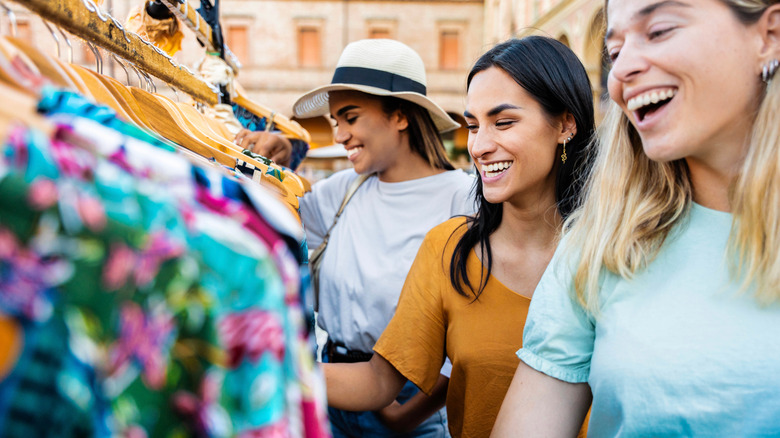Visiting This Type Of Clothing Store While Traveling Can Enhance Your Experience Abroad
Travel and shopping go hand in hand, and they always have. Thousands of years ago, merchants crossed seas and deserts to trade wares, and the tradition has continued, uninterrupted, to the present day. People travel for all different reasons, but most of us do end up buying stuff, whether it's a souvenir shot glass from Niagara Falls or an authentic Boruca mask from rural Costa Rica. One of the most popular forms of merchandise is clothing; tourists love to show up in a new place, browse the local stores, and walk off with a graphic tee or iconic local garb. A sombrero from Mexico? Check. A sarong from Indonesia? Got it. A thawb from Qatar? But of course!
But discriminating travelers may frown on this kind of superficial purchase. There's nothing special about a generic shirt that reads, "Aruba, Est. 1499. One Happy Island," and while it may remind us of a fun vacation, we also know that it's mass-produced kitsch, most likely printed in a factory thousands of miles from where we bought it. Some travelers also roll their eyes at amassing stereotypical garments, like conical hats in Vietnam and lederhosen in Germany, which may smack of cultural appropriation. Tourists should also avoid buying or bringing fake luxury items to these European countries.
Here's a nifty alternative to both: visiting a local vintage clothing shop. These second-hand retailers can be found in trendy neighborhoods all over the world, and they have only grown more popular in recent decades with the proliferation of the "hipster" movement. Here you'll find vestments that are chic, unique, and reflect the people who actually live nearby. You may also find bargains; vintage clothing is one of many budget-friendly souvenir ideas to consider for your next trip.
The pleasures of shopping vintage while traveling
What is a vintage clothing store, exactly? Most of us are familiar with second-hand stores like the Salvation Army or Goodwill, which rely on donations and sell low-priced items to fund their nonprofits and community programs. Those stores are fantastic, and you can often find them internationally. Still, many people think of a "vintage store" as something else: Owners are more selective about what they put on their racks, and they often cultivate a fun and fashionable environment. This isn't just a place to buy old clothes; here, you assemble a real outfit. Younger generations breathe new life into outdated fashions; the long-abandoned bellbottoms, disco shirts, jelly sandals, cat-eye sunglasses, trilby hats, and piano ties look fresh and new — or, at least, pleasingly ironic.
Historically, many vintage clothiers purchased their clothes from customers or sold them on consignment, which meant there was a high probability that items were locally sourced and represented the people who lived nearby. You might spot a decades-old broach or pair of clogs that you couldn't possibly find anywhere else; trousers, blouses, and skirts might represent regional fashions that weren't well known elsewhere. Today, many vintage store owners turn to internet commerce or wholesalers to procure hot commodities, which could mean less community flair. Still, discerning vintage stores curate for taste and originality, and a pair of leather gloves from a boutique in Lyons is a far more personal purchase than anything you'd find in that city's H&M. While you're seeking out authenticity, here are some so-called "tourist traps" that Rick Steves loves.

